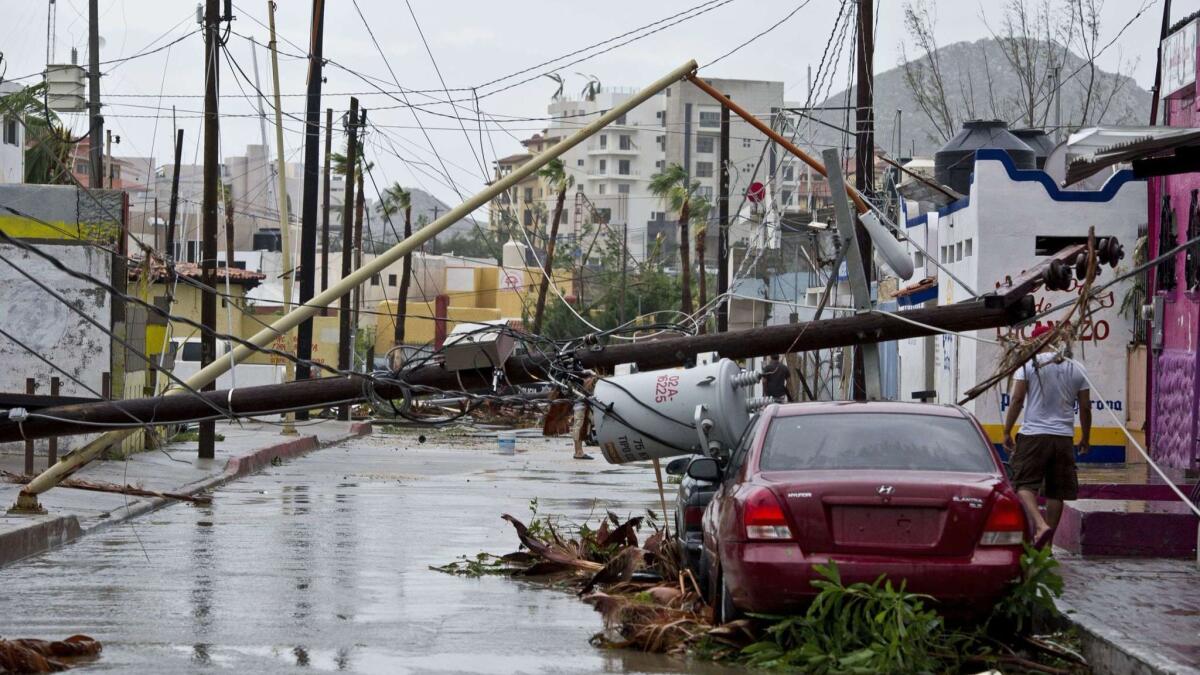Opinion: Insurers denied Mexico ‘cat bond’ payouts after Hurricane Odile due to my data. The system is broken

- Share via
I was standing in a hotel lobby in Cabo San Lucas, Mexico, one night in September 2014. Suddenly the windows exploded — like a bomb going off — and the walls and ceiling started to blow away. Diving under the reception desk, my legs bloody from flying glass, I kept my camera rolling and recorded the incredible onslaught of Hurricane Odile.
Welcome to my world.
I chase hurricanes. I’m not a scientist but I collect field data that scientists use. My passion puts me in dangerous situations around the globe. The payoff: documenting nature at its most awe-inspiring moments.
Odile was no exception. While I crawled across the lobby floor, bruised and bleeding, to find safety, one of my carefully calibrated instruments was up in my room, recording air-pressure data in a controlled environment. Air pressure drops as a hurricane approaches, and it’s usually lowest in the center — the calm eye. When Odile’s eye arrived and the roaring winds stopped for an hour, my device recorded its lowest pressure — 943.1 millibars — then rose as the eye moved away.
I’ve been in dozens of hurricanes. I’ve seen bad ones. But even I was shocked at Odile’s devastation. Cabo San Lucas was mauled. The outside of my hotel looked like piranhas had attacked it. The large concrete building next door had collapsed into a mountain of rubble, crushing cars. Steel lampposts were bent to the ground. That’s how the whole city looked. Nothing this bad had ever struck Los Cabos.
So imagine my surprise months later to find out Mexico was denied an insurance payout because the air pressure in Odile’s center — assessed from my data — wasn’t low enough. It was around this time I noticed financial and insurance folks praising my work on Twitter. That’s when I learned about catastrophe bonds (“cat bonds”), which are basically insurance policies that pay the customer (in this case, Mexico) only if the hurricane’s central pressure is low enough.
And imagine how unhappy I was to find myself at the center of the controversy reported in the Los Angeles Times’ article, “Mexico’s disaster bonds were meant to provide quick cash after hurricanes and earthquakes. But it often hasn’t worked out that way.”
I’m not a financial or insurance guy — and I’m frankly not interested in those worlds. I can comment only on what I know, which is hurricanes. And I’ll say this: A hurricane’s central pressure doesn’t tell you much about its destructive potential. So I’m amazed insurance products are tied to this metric.
Generally, the lower the air pressure in a hurricane’s center, the stronger the winds. But this relationship isn’t fixed — there are other factors. Therefore, you can have two hurricanes with the same central pressure — say, 960 millibars — but one has winds of 90 mph and the other has winds of 120 mph. So, central pressure is only a very loose proxy for a hurricane’s strength.
This aside, strength is only one ingredient for creating destruction. The other is size. A large, weak hurricane can do more damage than a tiny, strong one because it impacts more people. Given this, a combination of maximum sustained wind and size yields a better understanding of a hurricane’s destructive potential than the central pressure.
But wait — it’s even more complicated, because a hurricane’s rains can cause catastrophic flooding. These rainfall totals are totally unrelated to the other factors, and “weak” hurricanes can produce extreme rainfall.
Bottom line: Hurricanes are complex things, and each is unique — so you can’t reduce an impact event to a single meteorological metric. And if you have to, central pressure isn’t the one.
What matters is the human impact — the destruction.
To the devastated communities in Cabo San Lucas, Odile’s central pressure was purely academic. And an insurance system that denies payout because a hurricane’s central pressure wasn’t low enough makes as much sense as a fire-insurance policy that rejects a claim because scientists examined the wreckage and concluded the temperature never went over 1,300 degrees. Who cares how hot it was? The house burned down.
I hope the insurance industry stops offering so-called catastrophe bonds that link payouts to a hurricane’s central air pressure — or any other meteorological metrics — and instead focuses on the human impact. Until such common-sense reform happens, I caution customers (like Mexico) against investing in such bonds.
Josh Morgerman is the founder of iCyclone (Twitter: @iCyclone), which collects real-time data from hurricanes.
This piece is part of Blowback, our online forum for rebuttals to The Times. If you would like to write a full-length response to a recent Times article, editorial or Op-Ed and would like to participate in Blowback, here are our FAQs and submission policy.
Follow the Opinion section on Twitter @latimesopinion and Facebook
More to Read
A cure for the common opinion
Get thought-provoking perspectives with our weekly newsletter.
You may occasionally receive promotional content from the Los Angeles Times.







